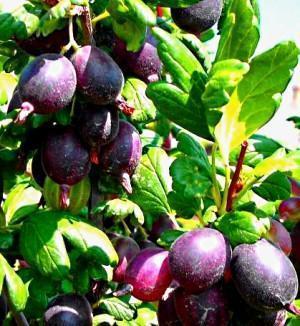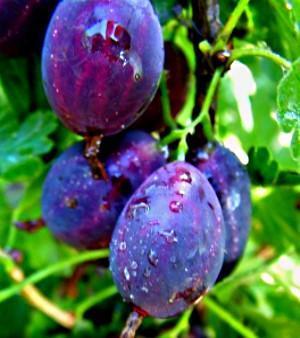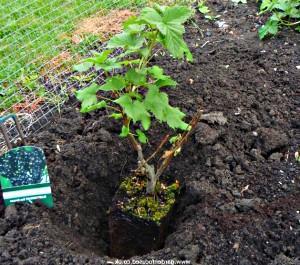Gooseberry Grushenka - planting and care
 With the growing popularity of gooseberries, breeders are developing new varieties that are noted for variety and perfection. They are more resistant to diseases and pests
, are characterized by high yield and low prickly bushes. Gooseberry Grushenka belongs to these varieties.
With the growing popularity of gooseberries, breeders are developing new varieties that are noted for variety and perfection. They are more resistant to diseases and pests
, are characterized by high yield and low prickly bushes. Gooseberry Grushenka belongs to these varieties.
The result of the fruitful work of breeding institutes is the gooseberry variety Grushenka - one of the most popular fruit and berry bushes. It is distinguished by the rounded pear-shaped shape of the berries, for which it got its name. The variety was artificially bred by the All-Russian Selection and Technical Institute of Horticulture and Nursery.
Description of the variety
According to the description of the grushenka gooseberry variety, one can note its good survival rate on any type of soil. The only requirement is timely feeding and an open place with direct sunlight.

As for the ripening of berries, the plant is not very late. The yield of one gooseberry bush “Grushenka” is about 6 kg. for the season. The berries are purple in color and have an average weight of 4.3 g. They are located along the entire length of annual shoots and adult branches. The pleasant sweet and sour taste of the fruit makes this variety one of the most desirable fruit and berry crops of the summer cottage. Pectin and anthocyanin compounds are a lot of berries. "Grushenka" bears fruit for about 20 years.
The main feature of the bush of this variety is frost resistance. Summer residents (even those who rarely visit the dacha) should not worry that his favorite gooseberry variety can freeze and disappear. Also, this variety has a unique resistance to the influence of powdery mildew, various viral diseases and septoria. Such features only emphasize the versatility of the look.
Yielding fruiting and high-quality large fruits did not allow leaving a single negative statement about this variety. One of the summer residents notes: “Sometimes you can't even see the leaves because of the fruits of Grushenka, they just stick around the bush, becoming a continuous abundance of berries.”
Features of planting gooseberry Grushenka
 The bush is planted in the soil, both in spring and autumn. The landing site should be permanent (the plant does not like transplants to another place) and be open to constant sunlight.
The bush is planted in the soil, both in spring and autumn. The landing site should be permanent (the plant does not like transplants to another place) and be open to constant sunlight.
If you plant a bush in spring, you need to focus on a very short period between thawing of the soil and swelling of the buds of the plant. The survival rate of a plant in a new place directly depends on this. In order not to miss and not be late, many summer residents recommend planting a gooseberry grushenka in the fall. This will allow you to be sure of a positive result.
Planting in the fall should be done 4 or 6 weeks before the onset of frost. Although the plant is also frost-resistant, it needs an adaptation period to gain strength before the onset of winter.By the onset of frost the Grushenka bush has time to acquire new shoots, which means its successful adaptation.
 When landing gooseberry should take into account the distance between the plants, since nearby planted bushes will intertwine, and this interferes with rapid growth and creates difficulties in harvesting.
When landing gooseberry should take into account the distance between the plants, since nearby planted bushes will intertwine, and this interferes with rapid growth and creates difficulties in harvesting.
The regulated distance should not be less than 1 meter; in some cases, gardeners plant bushes at a distance of 1.5-2 meters. Young seedlings with annual shoots are best planted in a half-meter hole with a diameter of 50x50cm.
An important factor will also be the introduction of fertilizers and organic nutrients when planting a bush. For one bush, you must apply:
- 40 grams of potassium sulfide.
- 50 grams double superphosphate.
- 100 grams of wood ash.
- About 5-10 kg. manure or humus.
Immediately before inserting the bush into the hole, it is necessary to examine it for the presence of dry roots, branches, and bad shoots. If there are any, it is best to remove them with a pruner. The tops of good branches should be cut 10-15 cm from the top.
In the prepared nest, the bush should be placed at a slight slope. Then carry out the process of filling the roots with earth. After that, it is necessary to lightly tamp it without damaging the bush itself. The final stage of planting the Grushenka gooseberry bush will be abundant watering under the root and around the plant.
Care
 Care principles for the gooseberry variety Grushenka, they contain a number of measures that contribute to increasing the efficiency of fruiting and the development of the plant as a whole.
Care principles for the gooseberry variety Grushenka, they contain a number of measures that contribute to increasing the efficiency of fruiting and the development of the plant as a whole.
In order for the gooseberry to consistently bring a high yield, it is necessary to constantly loosen the soil. The intensity and depth of this process must match the type of soil. On hard soils, you need to dig deeper, and on loose and soft soils, surface loosening is enough. Use a garden fork or a utility shovel with ripper as a tool.
It is very important to remove weeds from under the bush and around it in a timely manner. They take the necessary nutrients from the gooseberry and increase the moisture content of the soil, which is highly undesirable for the plant. Excessive moisture can be a prerequisite for viral diseases.
Introduction fertilizers is also an important step in the care of gooseberries. Twice a year (spring and autumn), you need to use a standard complex of nutrients (potassium chloride - 20 g, saltpeter - 40 g, superphosphate - 80 g, compost or manure - about 7 or 10 kg).
 Also, one of the main stages of caring for Grushenka gooseberries is the timely pruning of shoots and old branches, the formation of a bush. In the first years, root shoots are trimmed, then weak shoots are removed.
Also, one of the main stages of caring for Grushenka gooseberries is the timely pruning of shoots and old branches, the formation of a bush. In the first years, root shoots are trimmed, then weak shoots are removed.
With proper care, the peculiarities of the Grushenka gooseberry allow you to get an excellent harvest.